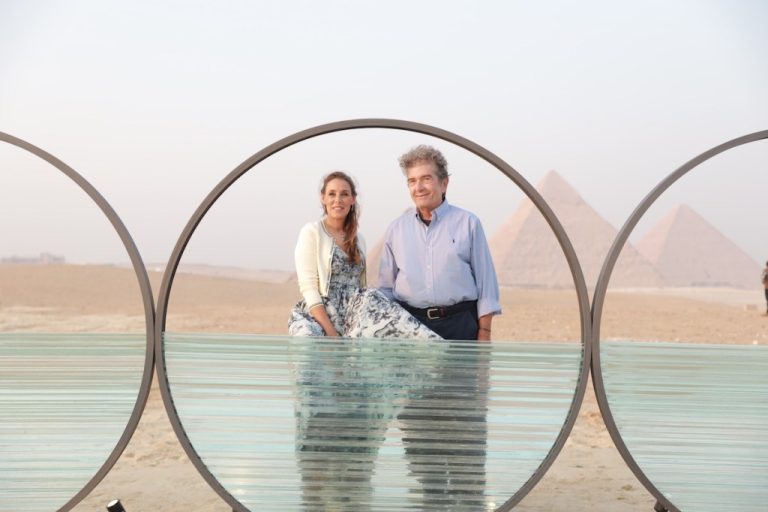Later this month, the Acropolis Museum in Athens will host a unique exhibition titled A Tale of Two Cities. The first half of the exhibition, which will run until July 16, will focus on the thousands of years of historical and cultural ties between Athens and the Egyptian city of Alexandria, while the second half of the exhibition will be held in October at the Bibliotheca Alexandrina and the Greco-Roman Museum.
The exhibition’s mix of historical and contemporary features is typical of its organizer, French-Egyptian curator and art consultant Nadine Abdel Ghaffar. Nearly 10 years ago, Ghaffar founded the art consultancy Art D’Egypte to address a problem: Egypt’s contemporary art had long struggled to gain the same international recognition as its rich historical artifacts and monumental archaeological landmarks. Rather than trying to escape history, Ghaffar decided to merge with it, staging high-profile exhibitions that used iconic sites such as the Great Pyramids of Giza as a backdrop to create a dialogue between the past and the present.
“The whole idea was to get away from the white cube and make something meaningful with the heritage or the space we were in,” Ghaffar told Art News“It’s a cultural platform. My point is that you can’t separate cultural heritage from art, music, theatre, film, design. They’re all intertwined.”
The most notable series at the Egyptian Art Fair is the recurring “Always Now” exhibition, which held its third edition last November. Held on the Giza Plateau, the show features large-scale sculptures and installations by 14 artists, many of whom draw inspiration from the location. For example, Saudi Arabian artist Rashed Al Shashai, whose work has appeared at the 2021 Diryah Biennial and multiple editions of the Noor Riyadh Light Festival, creates site-specific installations. Translucent Pyramid, A 20-foot-tall pyramid built from wicker boxes. Egyptian artist Mohamed Banawy also contributed As it goes up, so it goes down (Starry Dome)a 30-foot-tall installation featuring starfish-shaped sculptures that reference ancient Egyptian texts.

Mohammed al-Banawi So it goes up, so it goes down (starry dome), At the ‘Always Now’ exhibition in Giza, Egypt.
Image source: CulturVator
In 2022, Ghaffar launched CulturVator as an evolution of Art D’Égypte. While Art D’Égypte focused on local art, the larger brand CulturVator focuses on a wider cultural spectrum, including art, film, fashion and international projects such as “A Tale of Two Cities.” The exhibition will feature work by seven artists at the Acropolis Museum—three Greek and four Egyptian, primarily from Alexandria. At the same time, CulturVator will host a “parallel” event at The Lemon Tree & Co. Athens-Riviera and its sister restaurant in Alexandria, Egypt, dedicated to the work of Egyptian artists. The lineup includes well-known artists such as Costas Varotsos, Danae Stratou, Omar Toussoun, Said Badr and Karim El Hayawan.
“As a Greek artist, I see this exhibition as a creative dialogue between two ancient centers of culture and wisdom,” said Dionysios Ka, whose work was featured in last November’s “Always Now” exhibition and will be on view in the upcoming exhibition. Art News“By connecting these two cities, Nadine has successfully reintegrated a rich historical connection – celebrating intertwined narratives and inviting audiences to reflect on the enduring legacy of these vibrant cities.”
At the heart of CulturVator’s work is a deep respect for history and its preservation. In “Eternity is Now,” 50 centimeters of sand were laid before any artwork was placed in order to protect the underlying historical soil. For the 2017 exhibition “Eternal Light: Something Old, Something New” at the Egyptian Museum in Cairo, Ghaffar paired more than a dozen contemporary artworks with ancient artifacts from the museum to find connections between them. She also worked with Azza Fahmy Jewellery to curate a special protective case to display jewelry from 19th-century Egyptian leader Muhammad Ali Pasha and his daughter, marking the first time these objects were on display to guests. CulturVator/Art D’Égypte and its outreach activities even operate under the auspices of UNESCO to “protect and promote the diversity of cultural expressions.”

This is a photo of the installation of CulturVator’s “If Walls Could Talk” exhibition at Salah al-Din Citadel, one of Cairo’s most famous landmarks.
Image source: CulturVator
The mission to preserve cultural heritage becomes even more important as urban development threatens historic sites. Cairo’s rapid transformation in recent years has resulted in many ancient tombs, cemeteries, and other historical landmarks being razed for new developments and roads. For example, since 2020, the Egyptian government has gradually demolished the historic City of the Dead Tombs, a UNESCO World Heritage Site. These efforts have continued over the past year. Meanwhile, in January, the government demolished Darb 1718, an iconic contemporary art center in the Fustat neighborhood, to make way for an elevated highway. The neighborhood, most of which has been demolished, was once home to Cairo’s last traditional artisans.
“You don’t live for yourself,” Gaffar said, adding that a community-focused mindset was instilled in her from a young age. “You’re put into the universe to do things for other people.”
Through Art D’Egypte and CulturVator, Ghaffar works to foster a healthy ecosystem, employing hundreds of workers to build the exhibitions and horse-drawn carriage drivers to guide visitors on art tours. According to Ghaffar, the organization’s mission to promote Egypt has allowed these workers to take pride in their contributions to the exhibitions, become friends with participating artists, and learn the stories of the artworks to educate visitors. This community-first spirit is perhaps best reflected in the fact that CulturVator’s exhibitions open with a public opening; private VIP exhibitions take place at a later date.
Jafar’s initiatives have boosted art-centric tourism, attracting international visitors who attend events she organizes. More than a thousand VIPs have come to see her “Always Now” exhibition, according to the organization.
Mohamed Awad, an architectural historian and consultant to the Library of Alexandria, told Art News “Nadine’s cultural expression brings Egyptian art into our contemporary culture. The motto is: Be proud to be Egyptian.”


